MBA 746A Good Governance: First Gen Corporation CSR Analysis 2022-23
VerifiedAdded on 2023/05/01
|20
|7391
|222
Case Study
AI Summary
This case study examines the Corporate Social Responsibility (CSR) programs of First Gen Corporation, a power generation company focused on renewable energy. The study classifies First Gen's CSR initiatives into three theaters: Theater 1 (philanthropy), Theater 2 (strategic CSR), and Theater 3 (transforming the business). Key programs such as Create for the Climate (CftC), Educational Incentive Program (EIP), Solid Waste Management Program of Manolo Fortich, and Tulong Upang Lumawak Angking Yaman (TULAY) Program are analyzed. The paper recommends strategies for moving programs towards strategic philanthropy, re-engineering the business value chain, and transforming the business, along with establishing a dedicated CSR unit to coordinate these efforts. The study also discusses the impact of the COVID-19 pandemic on First Gen's CSR activities and the opportunities for technological innovation in program delivery.
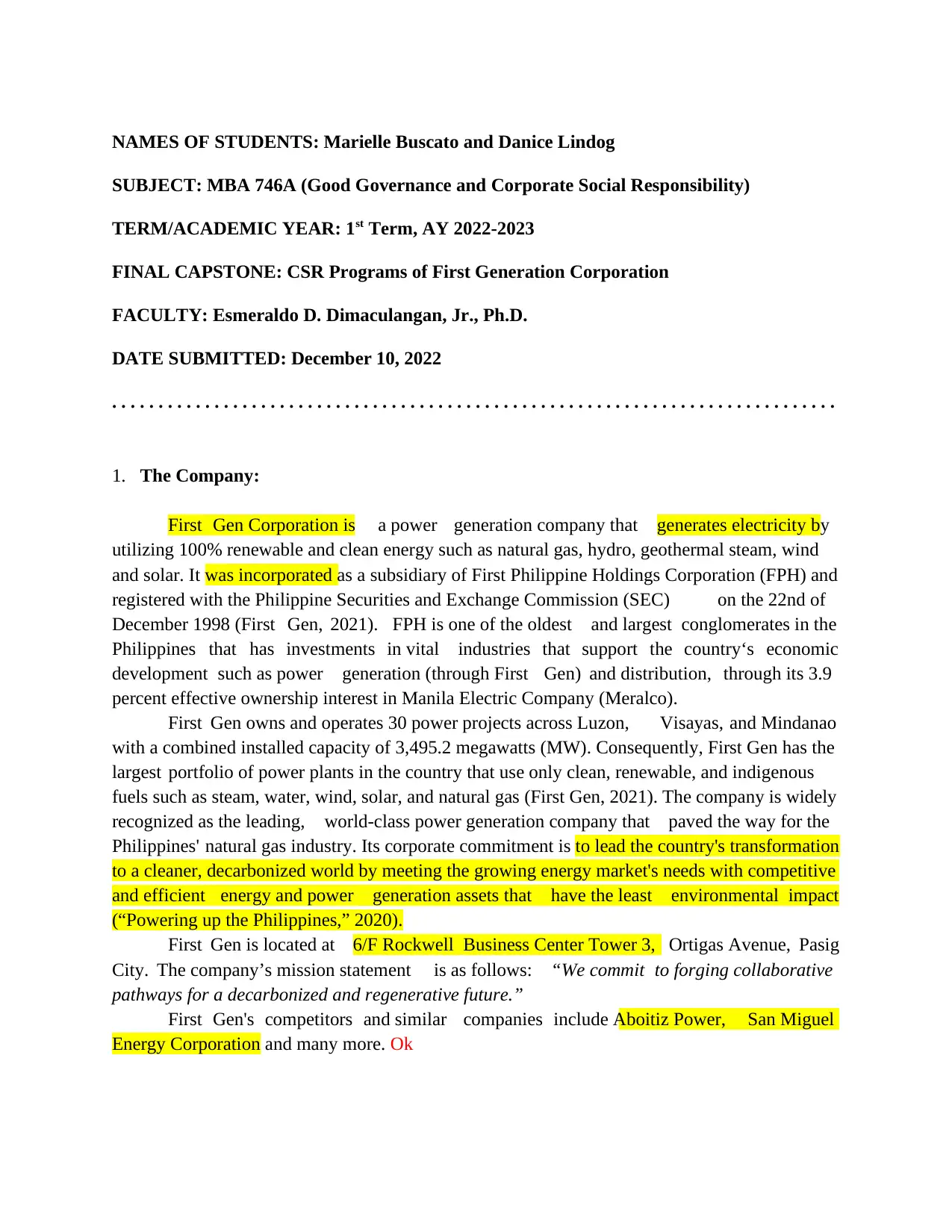
NAMES OF STUDENTS: Marielle Buscato and Danice Lindog
SUBJECT: MBA 746A (Good Governance and Corporate Social Responsibility)
TERM/ACADEMIC YEAR: 1st Term, AY 2022-2023
FINAL CAPSTONE: CSR Programs of First Generation Corporation
FACULTY: Esmeraldo D. Dimaculangan, Jr., Ph.D.
DATE SUBMITTED: December 10, 2022
. . . . . . . . . . . . . . . . . . . . . . . . . . . . . . . . . . . . . . . . . . . . . . . . . . . . . . . . . . . . . . . . . . . . . . . . . . . . . .
1. The Company:
First Gen Corporation is a power generation company that generates electricity by
utilizing 100% renewable and clean energy such as natural gas, hydro, geothermal steam, wind
and solar. It was incorporated as a subsidiary of First Philippine Holdings Corporation (FPH) and
registered with the Philippine Securities and Exchange Commission (SEC) on the 22nd of
December 1998 (First Gen, 2021). FPH is one of the oldest and largest conglomerates in the
Philippines that has investments in vital industries that support the country‘s economic
development such as power generation (through First Gen) and distribution, through its 3.9
percent effective ownership interest in Manila Electric Company (Meralco).
First Gen owns and operates 30 power projects across Luzon, Visayas, and Mindanao
with a combined installed capacity of 3,495.2 megawatts (MW). Consequently, First Gen has the
largest portfolio of power plants in the country that use only clean, renewable, and indigenous
fuels such as steam, water, wind, solar, and natural gas (First Gen, 2021). The company is widely
recognized as the leading, world-class power generation company that paved the way for the
Philippines' natural gas industry. Its corporate commitment is to lead the country's transformation
to a cleaner, decarbonized world by meeting the growing energy market's needs with competitive
and efficient energy and power generation assets that have the least environmental impact
(“Powering up the Philippines,” 2020).
First Gen is located at 6/F Rockwell Business Center Tower 3, Ortigas Avenue, Pasig
City. The company’s mission statement is as follows: “We commit to forging collaborative
pathways for a decarbonized and regenerative future.”
First Gen's competitors and similar companies include Aboitiz Power, San Miguel
Energy Corporation and many more. Ok
SUBJECT: MBA 746A (Good Governance and Corporate Social Responsibility)
TERM/ACADEMIC YEAR: 1st Term, AY 2022-2023
FINAL CAPSTONE: CSR Programs of First Generation Corporation
FACULTY: Esmeraldo D. Dimaculangan, Jr., Ph.D.
DATE SUBMITTED: December 10, 2022
. . . . . . . . . . . . . . . . . . . . . . . . . . . . . . . . . . . . . . . . . . . . . . . . . . . . . . . . . . . . . . . . . . . . . . . . . . . . . .
1. The Company:
First Gen Corporation is a power generation company that generates electricity by
utilizing 100% renewable and clean energy such as natural gas, hydro, geothermal steam, wind
and solar. It was incorporated as a subsidiary of First Philippine Holdings Corporation (FPH) and
registered with the Philippine Securities and Exchange Commission (SEC) on the 22nd of
December 1998 (First Gen, 2021). FPH is one of the oldest and largest conglomerates in the
Philippines that has investments in vital industries that support the country‘s economic
development such as power generation (through First Gen) and distribution, through its 3.9
percent effective ownership interest in Manila Electric Company (Meralco).
First Gen owns and operates 30 power projects across Luzon, Visayas, and Mindanao
with a combined installed capacity of 3,495.2 megawatts (MW). Consequently, First Gen has the
largest portfolio of power plants in the country that use only clean, renewable, and indigenous
fuels such as steam, water, wind, solar, and natural gas (First Gen, 2021). The company is widely
recognized as the leading, world-class power generation company that paved the way for the
Philippines' natural gas industry. Its corporate commitment is to lead the country's transformation
to a cleaner, decarbonized world by meeting the growing energy market's needs with competitive
and efficient energy and power generation assets that have the least environmental impact
(“Powering up the Philippines,” 2020).
First Gen is located at 6/F Rockwell Business Center Tower 3, Ortigas Avenue, Pasig
City. The company’s mission statement is as follows: “We commit to forging collaborative
pathways for a decarbonized and regenerative future.”
First Gen's competitors and similar companies include Aboitiz Power, San Miguel
Energy Corporation and many more. Ok
Paraphrase This Document
Need a fresh take? Get an instant paraphrase of this document with our AI Paraphraser
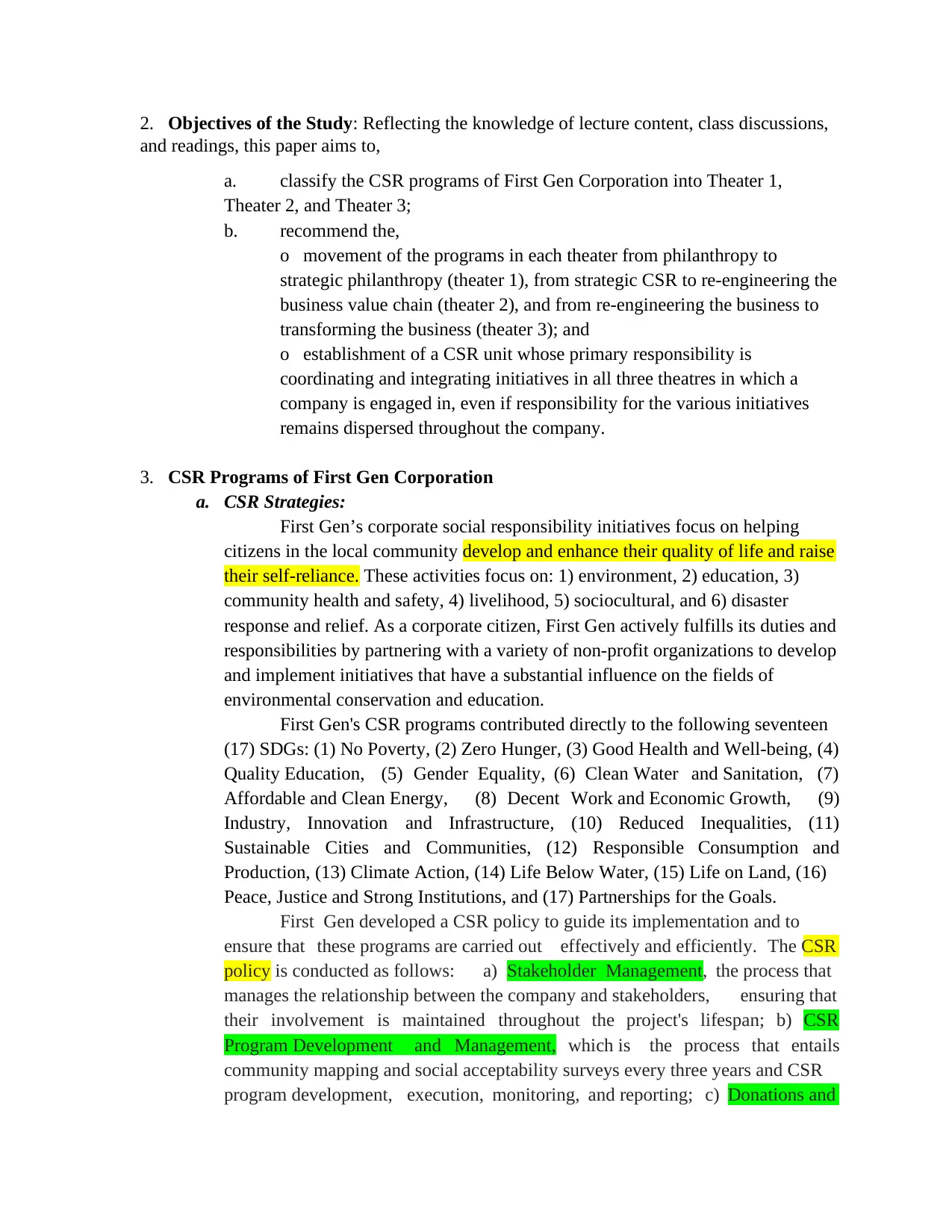
2. Objectives of the Study: Reflecting the knowledge of lecture content, class discussions,
and readings, this paper aims to,
a. classify the CSR programs of First Gen Corporation into Theater 1,
Theater 2, and Theater 3;
b. recommend the,
o movement of the programs in each theater from philanthropy to
strategic philanthropy (theater 1), from strategic CSR to re-engineering the
business value chain (theater 2), and from re-engineering the business to
transforming the business (theater 3); and
o establishment of a CSR unit whose primary responsibility is
coordinating and integrating initiatives in all three theatres in which a
company is engaged in, even if responsibility for the various initiatives
remains dispersed throughout the company.
3. CSR Programs of First Gen Corporation
a. CSR Strategies:
First Gen’s corporate social responsibility initiatives focus on helping
citizens in the local community develop and enhance their quality of life and raise
their self-reliance. These activities focus on: 1) environment, 2) education, 3)
community health and safety, 4) livelihood, 5) sociocultural, and 6) disaster
response and relief. As a corporate citizen, First Gen actively fulfills its duties and
responsibilities by partnering with a variety of non-profit organizations to develop
and implement initiatives that have a substantial influence on the fields of
environmental conservation and education.
First Gen's CSR programs contributed directly to the following seventeen
(17) SDGs: (1) No Poverty, (2) Zero Hunger, (3) Good Health and Well-being, (4)
Quality Education, (5) Gender Equality, (6) Clean Water and Sanitation, (7)
Affordable and Clean Energy, (8) Decent Work and Economic Growth, (9)
Industry, Innovation and Infrastructure, (10) Reduced Inequalities, (11)
Sustainable Cities and Communities, (12) Responsible Consumption and
Production, (13) Climate Action, (14) Life Below Water, (15) Life on Land, (16)
Peace, Justice and Strong Institutions, and (17) Partnerships for the Goals.
First Gen developed a CSR policy to guide its implementation and to
ensure that these programs are carried out effectively and efficiently. The CSR
policy is conducted as follows: a) Stakeholder Management, the process that
manages the relationship between the company and stakeholders, ensuring that
their involvement is maintained throughout the project's lifespan; b) CSR
Program Development and Management, which is the process that entails
community mapping and social acceptability surveys every three years and CSR
program development, execution, monitoring, and reporting; c) Donations and
and readings, this paper aims to,
a. classify the CSR programs of First Gen Corporation into Theater 1,
Theater 2, and Theater 3;
b. recommend the,
o movement of the programs in each theater from philanthropy to
strategic philanthropy (theater 1), from strategic CSR to re-engineering the
business value chain (theater 2), and from re-engineering the business to
transforming the business (theater 3); and
o establishment of a CSR unit whose primary responsibility is
coordinating and integrating initiatives in all three theatres in which a
company is engaged in, even if responsibility for the various initiatives
remains dispersed throughout the company.
3. CSR Programs of First Gen Corporation
a. CSR Strategies:
First Gen’s corporate social responsibility initiatives focus on helping
citizens in the local community develop and enhance their quality of life and raise
their self-reliance. These activities focus on: 1) environment, 2) education, 3)
community health and safety, 4) livelihood, 5) sociocultural, and 6) disaster
response and relief. As a corporate citizen, First Gen actively fulfills its duties and
responsibilities by partnering with a variety of non-profit organizations to develop
and implement initiatives that have a substantial influence on the fields of
environmental conservation and education.
First Gen's CSR programs contributed directly to the following seventeen
(17) SDGs: (1) No Poverty, (2) Zero Hunger, (3) Good Health and Well-being, (4)
Quality Education, (5) Gender Equality, (6) Clean Water and Sanitation, (7)
Affordable and Clean Energy, (8) Decent Work and Economic Growth, (9)
Industry, Innovation and Infrastructure, (10) Reduced Inequalities, (11)
Sustainable Cities and Communities, (12) Responsible Consumption and
Production, (13) Climate Action, (14) Life Below Water, (15) Life on Land, (16)
Peace, Justice and Strong Institutions, and (17) Partnerships for the Goals.
First Gen developed a CSR policy to guide its implementation and to
ensure that these programs are carried out effectively and efficiently. The CSR
policy is conducted as follows: a) Stakeholder Management, the process that
manages the relationship between the company and stakeholders, ensuring that
their involvement is maintained throughout the project's lifespan; b) CSR
Program Development and Management, which is the process that entails
community mapping and social acceptability surveys every three years and CSR
program development, execution, monitoring, and reporting; c) Donations and
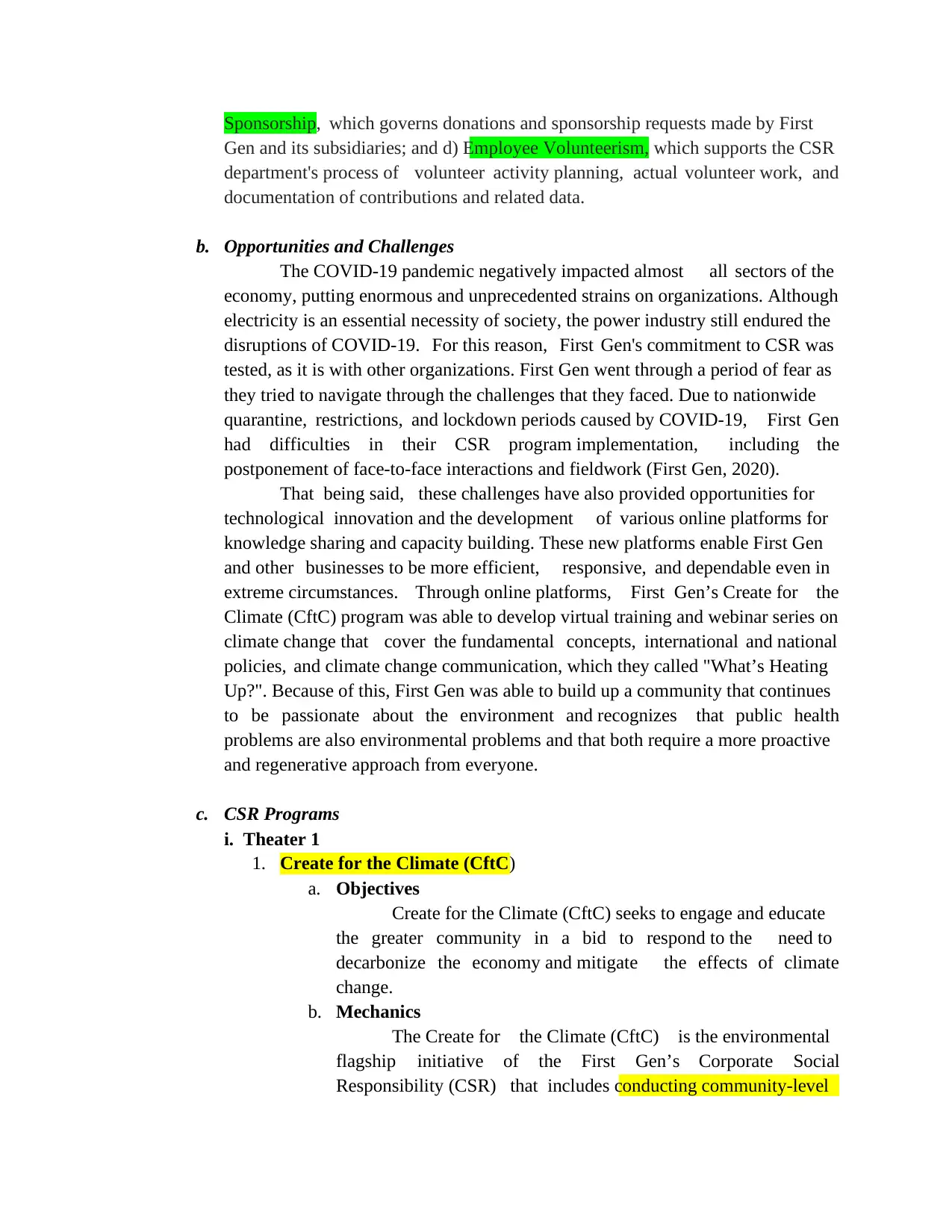
Sponsorship, which governs donations and sponsorship requests made by First
Gen and its subsidiaries; and d) Employee Volunteerism, which supports the CSR
department's process of volunteer activity planning, actual volunteer work, and
documentation of contributions and related data.
b. Opportunities and Challenges
The COVID-19 pandemic negatively impacted almost all sectors of the
economy, putting enormous and unprecedented strains on organizations. Although
electricity is an essential necessity of society, the power industry still endured the
disruptions of COVID-19. For this reason, First Gen's commitment to CSR was
tested, as it is with other organizations. First Gen went through a period of fear as
they tried to navigate through the challenges that they faced. Due to nationwide
quarantine, restrictions, and lockdown periods caused by COVID-19, First Gen
had difficulties in their CSR program implementation, including the
postponement of face-to-face interactions and fieldwork (First Gen, 2020).
That being said, these challenges have also provided opportunities for
technological innovation and the development of various online platforms for
knowledge sharing and capacity building. These new platforms enable First Gen
and other businesses to be more efficient, responsive, and dependable even in
extreme circumstances. Through online platforms, First Gen’s Create for the
Climate (CftC) program was able to develop virtual training and webinar series on
climate change that cover the fundamental concepts, international and national
policies, and climate change communication, which they called "What’s Heating
Up?". Because of this, First Gen was able to build up a community that continues
to be passionate about the environment and recognizes that public health
problems are also environmental problems and that both require a more proactive
and regenerative approach from everyone.
c. CSR Programs
i. Theater 1
1. Create for the Climate (CftC)
a. Objectives
Create for the Climate (CftC) seeks to engage and educate
the greater community in a bid to respond to the need to
decarbonize the economy and mitigate the effects of climate
change.
b. Mechanics
The Create for the Climate (CftC) is the environmental
flagship initiative of the First Gen’s Corporate Social
Responsibility (CSR) that includes conducting community-level
Gen and its subsidiaries; and d) Employee Volunteerism, which supports the CSR
department's process of volunteer activity planning, actual volunteer work, and
documentation of contributions and related data.
b. Opportunities and Challenges
The COVID-19 pandemic negatively impacted almost all sectors of the
economy, putting enormous and unprecedented strains on organizations. Although
electricity is an essential necessity of society, the power industry still endured the
disruptions of COVID-19. For this reason, First Gen's commitment to CSR was
tested, as it is with other organizations. First Gen went through a period of fear as
they tried to navigate through the challenges that they faced. Due to nationwide
quarantine, restrictions, and lockdown periods caused by COVID-19, First Gen
had difficulties in their CSR program implementation, including the
postponement of face-to-face interactions and fieldwork (First Gen, 2020).
That being said, these challenges have also provided opportunities for
technological innovation and the development of various online platforms for
knowledge sharing and capacity building. These new platforms enable First Gen
and other businesses to be more efficient, responsive, and dependable even in
extreme circumstances. Through online platforms, First Gen’s Create for the
Climate (CftC) program was able to develop virtual training and webinar series on
climate change that cover the fundamental concepts, international and national
policies, and climate change communication, which they called "What’s Heating
Up?". Because of this, First Gen was able to build up a community that continues
to be passionate about the environment and recognizes that public health
problems are also environmental problems and that both require a more proactive
and regenerative approach from everyone.
c. CSR Programs
i. Theater 1
1. Create for the Climate (CftC)
a. Objectives
Create for the Climate (CftC) seeks to engage and educate
the greater community in a bid to respond to the need to
decarbonize the economy and mitigate the effects of climate
change.
b. Mechanics
The Create for the Climate (CftC) is the environmental
flagship initiative of the First Gen’s Corporate Social
Responsibility (CSR) that includes conducting community-level
⊘ This is a preview!⊘
Do you want full access?
Subscribe today to unlock all pages.

Trusted by 1+ million students worldwide
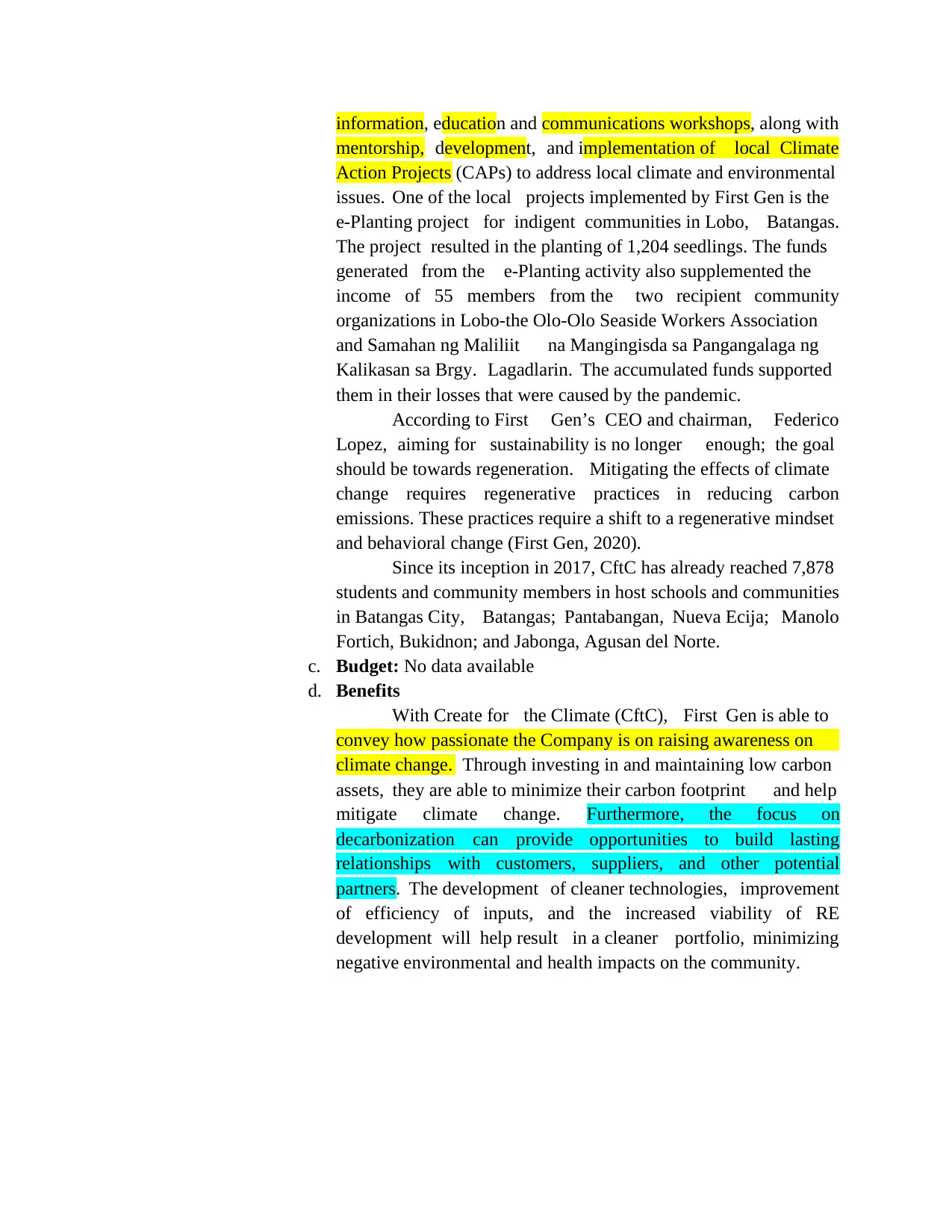
information, education and communications workshops, along with
mentorship, development, and implementation of local Climate
Action Projects (CAPs) to address local climate and environmental
issues. One of the local projects implemented by First Gen is the
e-Planting project for indigent communities in Lobo, Batangas.
The project resulted in the planting of 1,204 seedlings. The funds
generated from the e-Planting activity also supplemented the
income of 55 members from the two recipient community
organizations in Lobo-the Olo-Olo Seaside Workers Association
and Samahan ng Maliliit na Mangingisda sa Pangangalaga ng
Kalikasan sa Brgy. Lagadlarin. The accumulated funds supported
them in their losses that were caused by the pandemic.
According to First Gen’s CEO and chairman, Federico
Lopez, aiming for sustainability is no longer enough; the goal
should be towards regeneration. Mitigating the effects of climate
change requires regenerative practices in reducing carbon
emissions. These practices require a shift to a regenerative mindset
and behavioral change (First Gen, 2020).
Since its inception in 2017, CftC has already reached 7,878
students and community members in host schools and communities
in Batangas City, Batangas; Pantabangan, Nueva Ecija; Manolo
Fortich, Bukidnon; and Jabonga, Agusan del Norte.
c. Budget: No data available
d. Benefits
With Create for the Climate (CftC), First Gen is able to
convey how passionate the Company is on raising awareness on
climate change. Through investing in and maintaining low carbon
assets, they are able to minimize their carbon footprint and help
mitigate climate change. Furthermore, the focus on
decarbonization can provide opportunities to build lasting
relationships with customers, suppliers, and other potential
partners. The development of cleaner technologies, improvement
of efficiency of inputs, and the increased viability of RE
development will help result in a cleaner portfolio, minimizing
negative environmental and health impacts on the community.
mentorship, development, and implementation of local Climate
Action Projects (CAPs) to address local climate and environmental
issues. One of the local projects implemented by First Gen is the
e-Planting project for indigent communities in Lobo, Batangas.
The project resulted in the planting of 1,204 seedlings. The funds
generated from the e-Planting activity also supplemented the
income of 55 members from the two recipient community
organizations in Lobo-the Olo-Olo Seaside Workers Association
and Samahan ng Maliliit na Mangingisda sa Pangangalaga ng
Kalikasan sa Brgy. Lagadlarin. The accumulated funds supported
them in their losses that were caused by the pandemic.
According to First Gen’s CEO and chairman, Federico
Lopez, aiming for sustainability is no longer enough; the goal
should be towards regeneration. Mitigating the effects of climate
change requires regenerative practices in reducing carbon
emissions. These practices require a shift to a regenerative mindset
and behavioral change (First Gen, 2020).
Since its inception in 2017, CftC has already reached 7,878
students and community members in host schools and communities
in Batangas City, Batangas; Pantabangan, Nueva Ecija; Manolo
Fortich, Bukidnon; and Jabonga, Agusan del Norte.
c. Budget: No data available
d. Benefits
With Create for the Climate (CftC), First Gen is able to
convey how passionate the Company is on raising awareness on
climate change. Through investing in and maintaining low carbon
assets, they are able to minimize their carbon footprint and help
mitigate climate change. Furthermore, the focus on
decarbonization can provide opportunities to build lasting
relationships with customers, suppliers, and other potential
partners. The development of cleaner technologies, improvement
of efficiency of inputs, and the increased viability of RE
development will help result in a cleaner portfolio, minimizing
negative environmental and health impacts on the community.
Paraphrase This Document
Need a fresh take? Get an instant paraphrase of this document with our AI Paraphraser
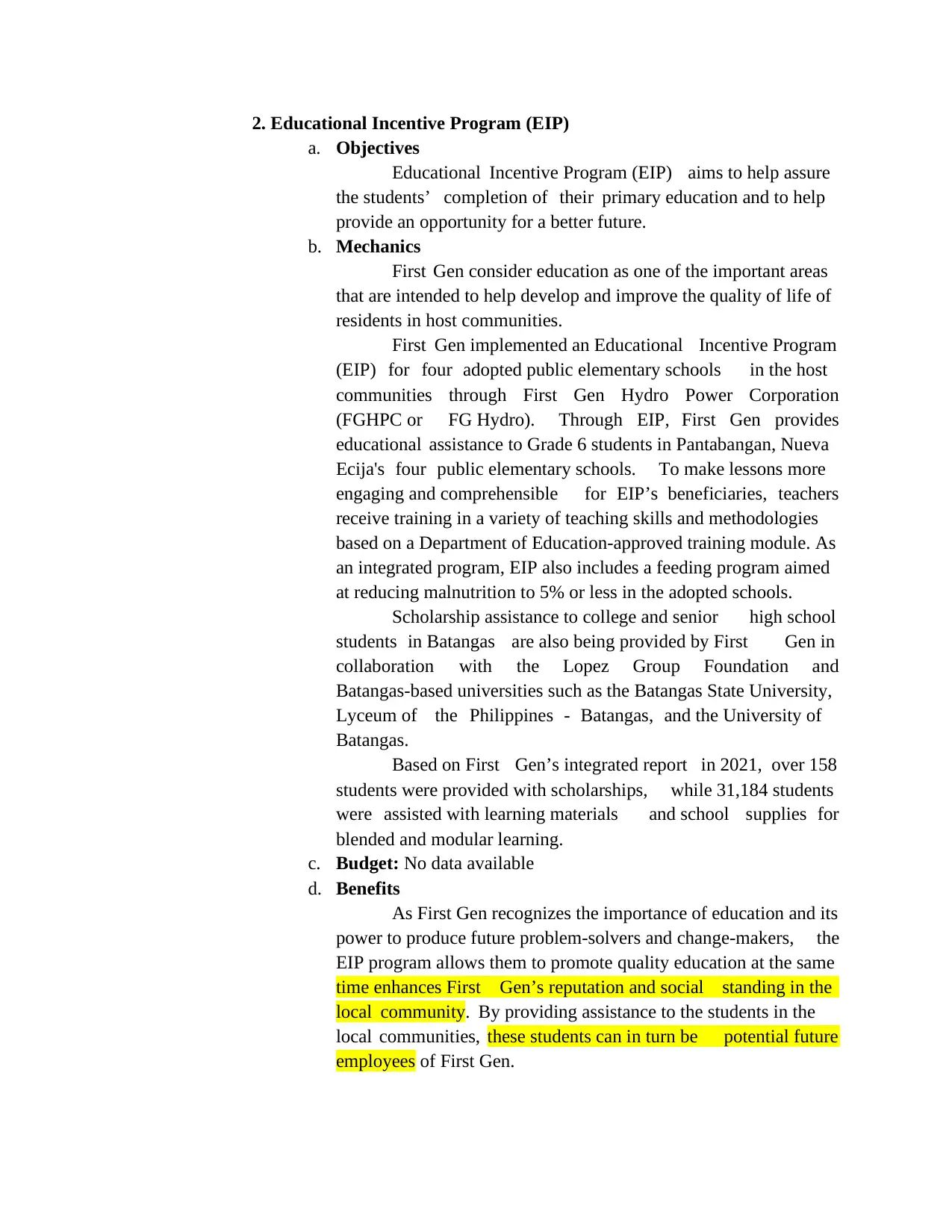
2. Educational Incentive Program (EIP)
a. Objectives
Educational Incentive Program (EIP) aims to help assure
the students’ completion of their primary education and to help
provide an opportunity for a better future.
b. Mechanics
First Gen consider education as one of the important areas
that are intended to help develop and improve the quality of life of
residents in host communities.
First Gen implemented an Educational Incentive Program
(EIP) for four adopted public elementary schools in the host
communities through First Gen Hydro Power Corporation
(FGHPC or FG Hydro). Through EIP, First Gen provides
educational assistance to Grade 6 students in Pantabangan, Nueva
Ecija's four public elementary schools. To make lessons more
engaging and comprehensible for EIP’s beneficiaries, teachers
receive training in a variety of teaching skills and methodologies
based on a Department of Education-approved training module. As
an integrated program, EIP also includes a feeding program aimed
at reducing malnutrition to 5% or less in the adopted schools.
Scholarship assistance to college and senior high school
students in Batangas are also being provided by First Gen in
collaboration with the Lopez Group Foundation and
Batangas-based universities such as the Batangas State University,
Lyceum of the Philippines - Batangas, and the University of
Batangas.
Based on First Gen’s integrated report in 2021, over 158
students were provided with scholarships, while 31,184 students
were assisted with learning materials and school supplies for
blended and modular learning.
c. Budget: No data available
d. Benefits
As First Gen recognizes the importance of education and its
power to produce future problem-solvers and change-makers, the
EIP program allows them to promote quality education at the same
time enhances First Gen’s reputation and social standing in the
local community. By providing assistance to the students in the
local communities, these students can in turn be potential future
employees of First Gen.
a. Objectives
Educational Incentive Program (EIP) aims to help assure
the students’ completion of their primary education and to help
provide an opportunity for a better future.
b. Mechanics
First Gen consider education as one of the important areas
that are intended to help develop and improve the quality of life of
residents in host communities.
First Gen implemented an Educational Incentive Program
(EIP) for four adopted public elementary schools in the host
communities through First Gen Hydro Power Corporation
(FGHPC or FG Hydro). Through EIP, First Gen provides
educational assistance to Grade 6 students in Pantabangan, Nueva
Ecija's four public elementary schools. To make lessons more
engaging and comprehensible for EIP’s beneficiaries, teachers
receive training in a variety of teaching skills and methodologies
based on a Department of Education-approved training module. As
an integrated program, EIP also includes a feeding program aimed
at reducing malnutrition to 5% or less in the adopted schools.
Scholarship assistance to college and senior high school
students in Batangas are also being provided by First Gen in
collaboration with the Lopez Group Foundation and
Batangas-based universities such as the Batangas State University,
Lyceum of the Philippines - Batangas, and the University of
Batangas.
Based on First Gen’s integrated report in 2021, over 158
students were provided with scholarships, while 31,184 students
were assisted with learning materials and school supplies for
blended and modular learning.
c. Budget: No data available
d. Benefits
As First Gen recognizes the importance of education and its
power to produce future problem-solvers and change-makers, the
EIP program allows them to promote quality education at the same
time enhances First Gen’s reputation and social standing in the
local community. By providing assistance to the students in the
local communities, these students can in turn be potential future
employees of First Gen.
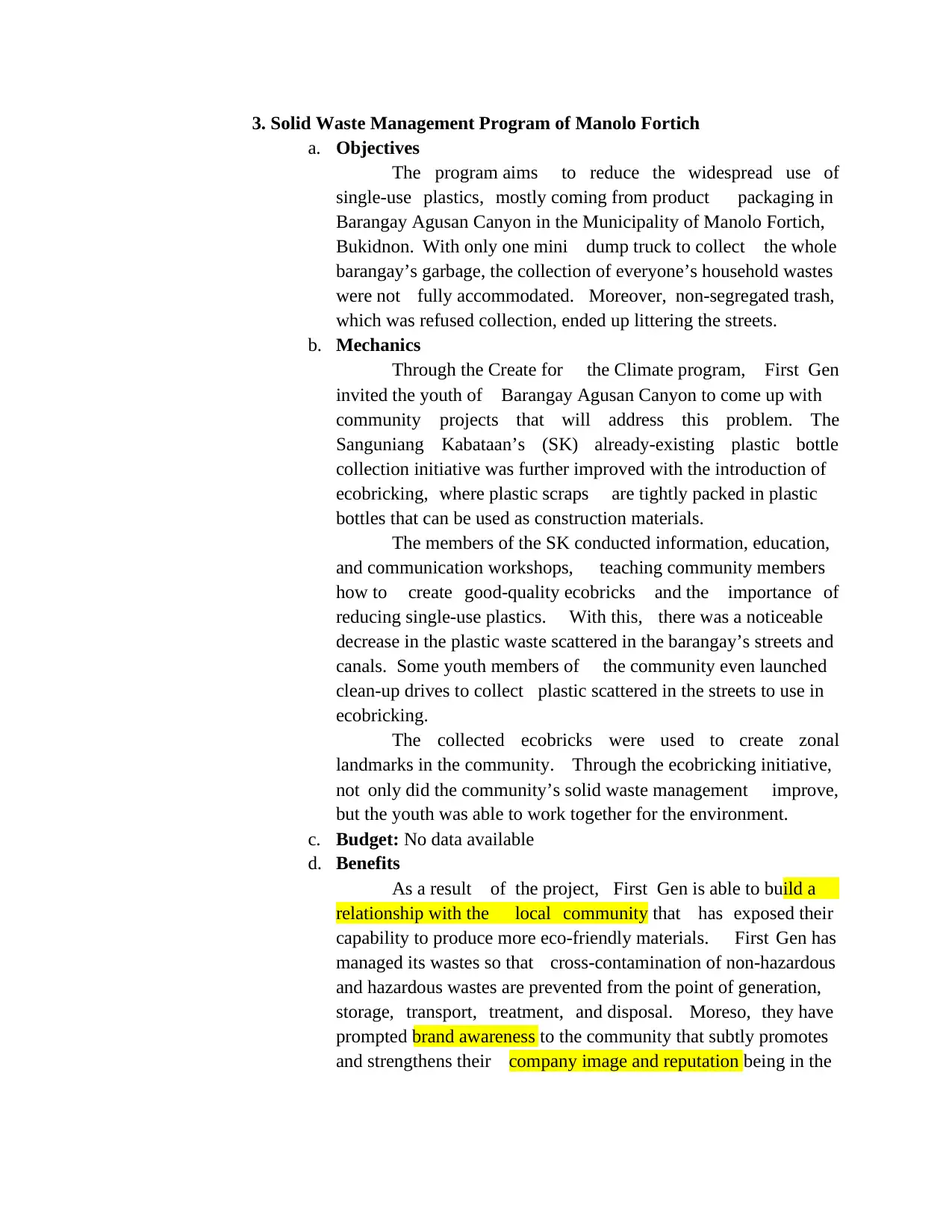
3. Solid Waste Management Program of Manolo Fortich
a. Objectives
The program aims to reduce the widespread use of
single-use plastics, mostly coming from product packaging in
Barangay Agusan Canyon in the Municipality of Manolo Fortich,
Bukidnon. With only one mini dump truck to collect the whole
barangay’s garbage, the collection of everyone’s household wastes
were not fully accommodated. Moreover, non-segregated trash,
which was refused collection, ended up littering the streets.
b. Mechanics
Through the Create for the Climate program, First Gen
invited the youth of Barangay Agusan Canyon to come up with
community projects that will address this problem. The
Sanguniang Kabataan’s (SK) already-existing plastic bottle
collection initiative was further improved with the introduction of
ecobricking, where plastic scraps are tightly packed in plastic
bottles that can be used as construction materials.
The members of the SK conducted information, education,
and communication workshops, teaching community members
how to create good-quality ecobricks and the importance of
reducing single-use plastics. With this, there was a noticeable
decrease in the plastic waste scattered in the barangay’s streets and
canals. Some youth members of the community even launched
clean-up drives to collect plastic scattered in the streets to use in
ecobricking.
The collected ecobricks were used to create zonal
landmarks in the community. Through the ecobricking initiative,
not only did the community’s solid waste management improve,
but the youth was able to work together for the environment.
c. Budget: No data available
d. Benefits
As a result of the project, First Gen is able to build a
relationship with the local community that has exposed their
capability to produce more eco-friendly materials. First Gen has
managed its wastes so that cross-contamination of non-hazardous
and hazardous wastes are prevented from the point of generation,
storage, transport, treatment, and disposal. Moreso, they have
prompted brand awareness to the community that subtly promotes
and strengthens their company image and reputation being in the
a. Objectives
The program aims to reduce the widespread use of
single-use plastics, mostly coming from product packaging in
Barangay Agusan Canyon in the Municipality of Manolo Fortich,
Bukidnon. With only one mini dump truck to collect the whole
barangay’s garbage, the collection of everyone’s household wastes
were not fully accommodated. Moreover, non-segregated trash,
which was refused collection, ended up littering the streets.
b. Mechanics
Through the Create for the Climate program, First Gen
invited the youth of Barangay Agusan Canyon to come up with
community projects that will address this problem. The
Sanguniang Kabataan’s (SK) already-existing plastic bottle
collection initiative was further improved with the introduction of
ecobricking, where plastic scraps are tightly packed in plastic
bottles that can be used as construction materials.
The members of the SK conducted information, education,
and communication workshops, teaching community members
how to create good-quality ecobricks and the importance of
reducing single-use plastics. With this, there was a noticeable
decrease in the plastic waste scattered in the barangay’s streets and
canals. Some youth members of the community even launched
clean-up drives to collect plastic scattered in the streets to use in
ecobricking.
The collected ecobricks were used to create zonal
landmarks in the community. Through the ecobricking initiative,
not only did the community’s solid waste management improve,
but the youth was able to work together for the environment.
c. Budget: No data available
d. Benefits
As a result of the project, First Gen is able to build a
relationship with the local community that has exposed their
capability to produce more eco-friendly materials. First Gen has
managed its wastes so that cross-contamination of non-hazardous
and hazardous wastes are prevented from the point of generation,
storage, transport, treatment, and disposal. Moreso, they have
prompted brand awareness to the community that subtly promotes
and strengthens their company image and reputation being in the
⊘ This is a preview!⊘
Do you want full access?
Subscribe today to unlock all pages.

Trusted by 1+ million students worldwide
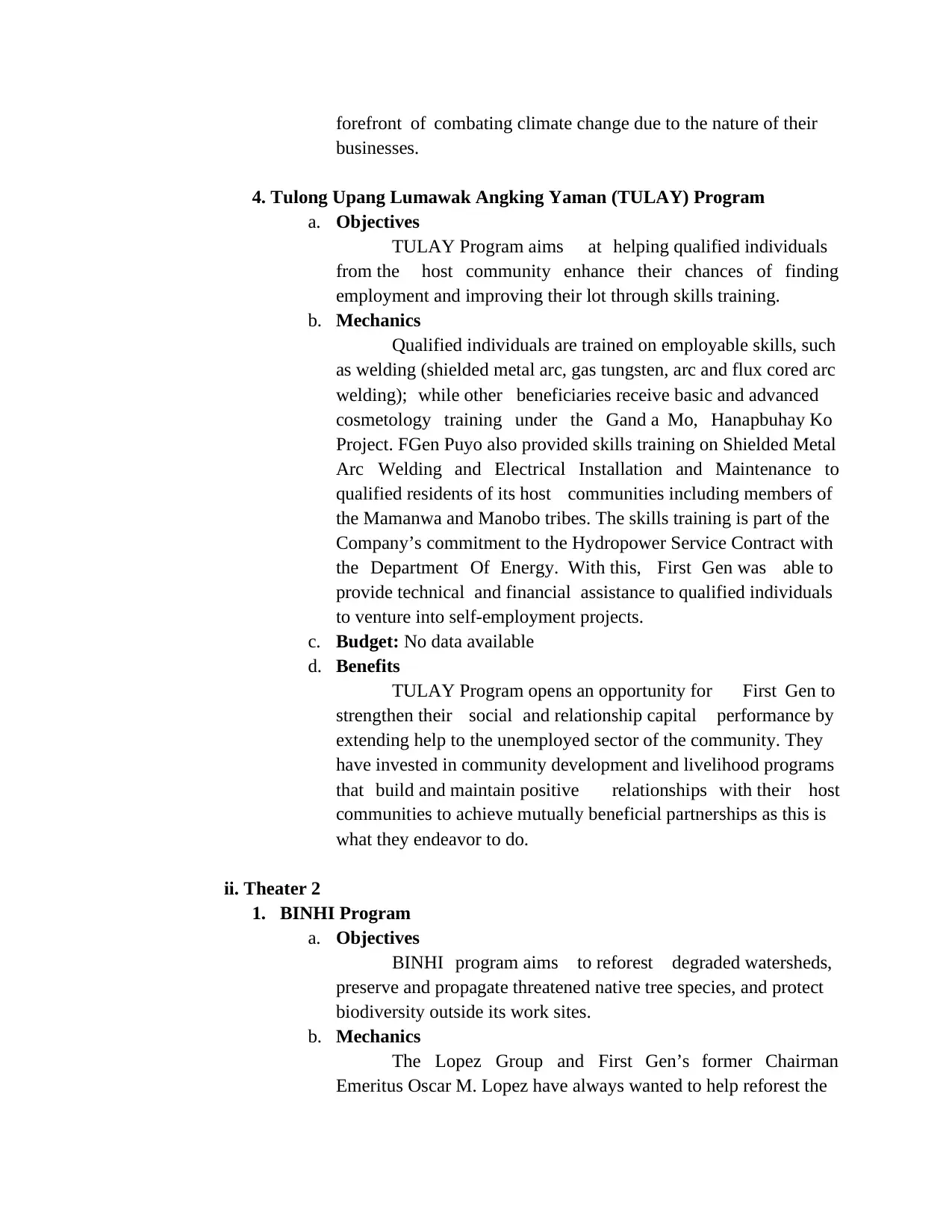
forefront of combating climate change due to the nature of their
businesses.
4. Tulong Upang Lumawak Angking Yaman (TULAY) Program
a. Objectives
TULAY Program aims at helping qualified individuals
from the host community enhance their chances of finding
employment and improving their lot through skills training.
b. Mechanics
Qualified individuals are trained on employable skills, such
as welding (shielded metal arc, gas tungsten, arc and flux cored arc
welding); while other beneficiaries receive basic and advanced
cosmetology training under the Gand a Mo, Hanapbuhay Ko
Project. FGen Puyo also provided skills training on Shielded Metal
Arc Welding and Electrical Installation and Maintenance to
qualified residents of its host communities including members of
the Mamanwa and Manobo tribes. The skills training is part of the
Company’s commitment to the Hydropower Service Contract with
the Department Of Energy. With this, First Gen was able to
provide technical and financial assistance to qualified individuals
to venture into self-employment projects.
c. Budget: No data available
d. Benefits
TULAY Program opens an opportunity for First Gen to
strengthen their social and relationship capital performance by
extending help to the unemployed sector of the community. They
have invested in community development and livelihood programs
that build and maintain positive relationships with their host
communities to achieve mutually beneficial partnerships as this is
what they endeavor to do.
ii. Theater 2
1. BINHI Program
a. Objectives
BINHI program aims to reforest degraded watersheds,
preserve and propagate threatened native tree species, and protect
biodiversity outside its work sites.
b. Mechanics
The Lopez Group and First Gen’s former Chairman
Emeritus Oscar M. Lopez have always wanted to help reforest the
businesses.
4. Tulong Upang Lumawak Angking Yaman (TULAY) Program
a. Objectives
TULAY Program aims at helping qualified individuals
from the host community enhance their chances of finding
employment and improving their lot through skills training.
b. Mechanics
Qualified individuals are trained on employable skills, such
as welding (shielded metal arc, gas tungsten, arc and flux cored arc
welding); while other beneficiaries receive basic and advanced
cosmetology training under the Gand a Mo, Hanapbuhay Ko
Project. FGen Puyo also provided skills training on Shielded Metal
Arc Welding and Electrical Installation and Maintenance to
qualified residents of its host communities including members of
the Mamanwa and Manobo tribes. The skills training is part of the
Company’s commitment to the Hydropower Service Contract with
the Department Of Energy. With this, First Gen was able to
provide technical and financial assistance to qualified individuals
to venture into self-employment projects.
c. Budget: No data available
d. Benefits
TULAY Program opens an opportunity for First Gen to
strengthen their social and relationship capital performance by
extending help to the unemployed sector of the community. They
have invested in community development and livelihood programs
that build and maintain positive relationships with their host
communities to achieve mutually beneficial partnerships as this is
what they endeavor to do.
ii. Theater 2
1. BINHI Program
a. Objectives
BINHI program aims to reforest degraded watersheds,
preserve and propagate threatened native tree species, and protect
biodiversity outside its work sites.
b. Mechanics
The Lopez Group and First Gen’s former Chairman
Emeritus Oscar M. Lopez have always wanted to help reforest the
Paraphrase This Document
Need a fresh take? Get an instant paraphrase of this document with our AI Paraphraser
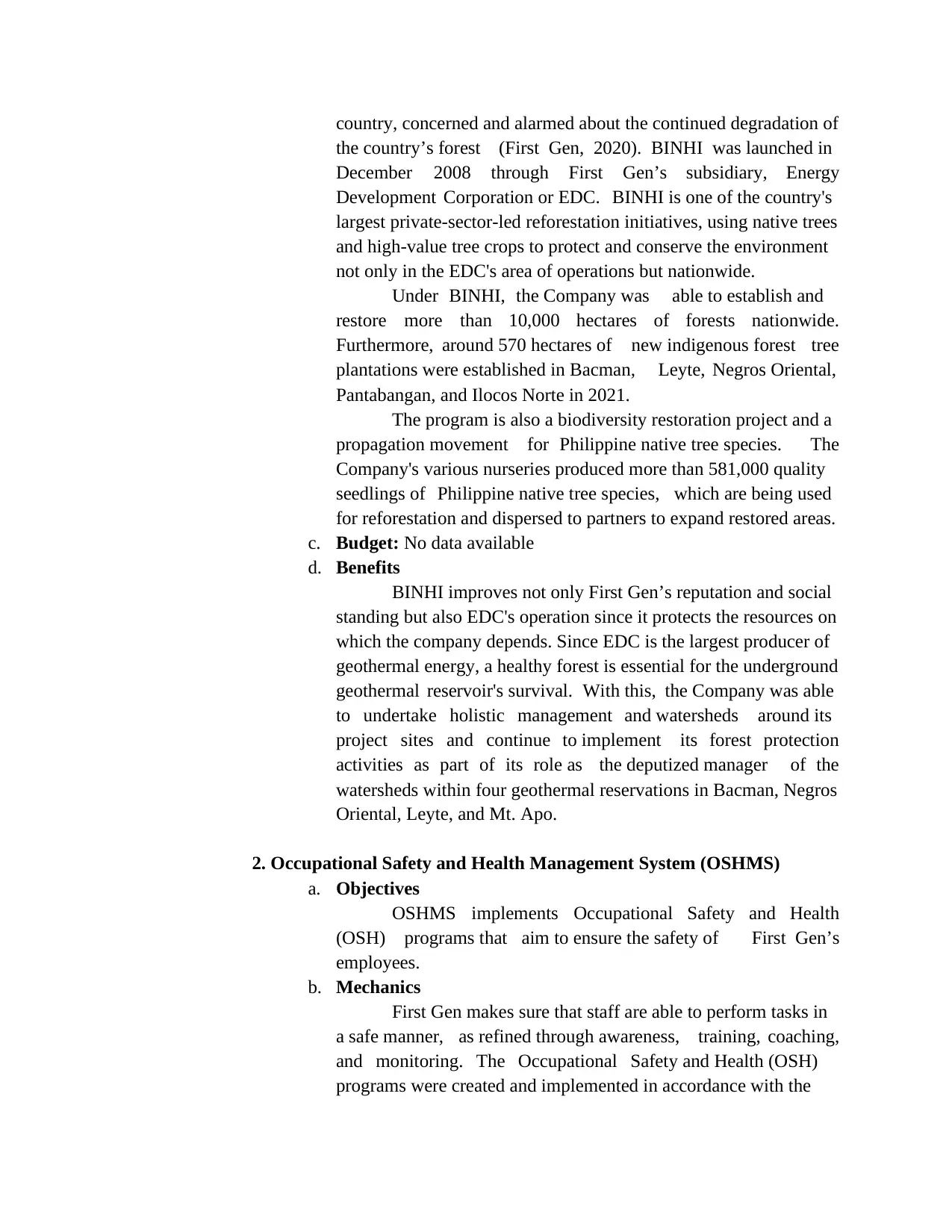
country, concerned and alarmed about the continued degradation of
the country’s forest (First Gen, 2020). BINHI was launched in
December 2008 through First Gen’s subsidiary, Energy
Development Corporation or EDC. BINHI is one of the country's
largest private-sector-led reforestation initiatives, using native trees
and high-value tree crops to protect and conserve the environment
not only in the EDC's area of operations but nationwide.
Under BINHI, the Company was able to establish and
restore more than 10,000 hectares of forests nationwide.
Furthermore, around 570 hectares of new indigenous forest tree
plantations were established in Bacman, Leyte, Negros Oriental,
Pantabangan, and Ilocos Norte in 2021.
The program is also a biodiversity restoration project and a
propagation movement for Philippine native tree species. The
Company's various nurseries produced more than 581,000 quality
seedlings of Philippine native tree species, which are being used
for reforestation and dispersed to partners to expand restored areas.
c. Budget: No data available
d. Benefits
BINHI improves not only First Gen’s reputation and social
standing but also EDC's operation since it protects the resources on
which the company depends. Since EDC is the largest producer of
geothermal energy, a healthy forest is essential for the underground
geothermal reservoir's survival. With this, the Company was able
to undertake holistic management and watersheds around its
project sites and continue to implement its forest protection
activities as part of its role as the deputized manager of the
watersheds within four geothermal reservations in Bacman, Negros
Oriental, Leyte, and Mt. Apo.
2. Occupational Safety and Health Management System (OSHMS)
a. Objectives
OSHMS implements Occupational Safety and Health
(OSH) programs that aim to ensure the safety of First Gen’s
employees.
b. Mechanics
First Gen makes sure that staff are able to perform tasks in
a safe manner, as refined through awareness, training, coaching,
and monitoring. The Occupational Safety and Health (OSH)
programs were created and implemented in accordance with the
the country’s forest (First Gen, 2020). BINHI was launched in
December 2008 through First Gen’s subsidiary, Energy
Development Corporation or EDC. BINHI is one of the country's
largest private-sector-led reforestation initiatives, using native trees
and high-value tree crops to protect and conserve the environment
not only in the EDC's area of operations but nationwide.
Under BINHI, the Company was able to establish and
restore more than 10,000 hectares of forests nationwide.
Furthermore, around 570 hectares of new indigenous forest tree
plantations were established in Bacman, Leyte, Negros Oriental,
Pantabangan, and Ilocos Norte in 2021.
The program is also a biodiversity restoration project and a
propagation movement for Philippine native tree species. The
Company's various nurseries produced more than 581,000 quality
seedlings of Philippine native tree species, which are being used
for reforestation and dispersed to partners to expand restored areas.
c. Budget: No data available
d. Benefits
BINHI improves not only First Gen’s reputation and social
standing but also EDC's operation since it protects the resources on
which the company depends. Since EDC is the largest producer of
geothermal energy, a healthy forest is essential for the underground
geothermal reservoir's survival. With this, the Company was able
to undertake holistic management and watersheds around its
project sites and continue to implement its forest protection
activities as part of its role as the deputized manager of the
watersheds within four geothermal reservations in Bacman, Negros
Oriental, Leyte, and Mt. Apo.
2. Occupational Safety and Health Management System (OSHMS)
a. Objectives
OSHMS implements Occupational Safety and Health
(OSH) programs that aim to ensure the safety of First Gen’s
employees.
b. Mechanics
First Gen makes sure that staff are able to perform tasks in
a safe manner, as refined through awareness, training, coaching,
and monitoring. The Occupational Safety and Health (OSH)
programs were created and implemented in accordance with the
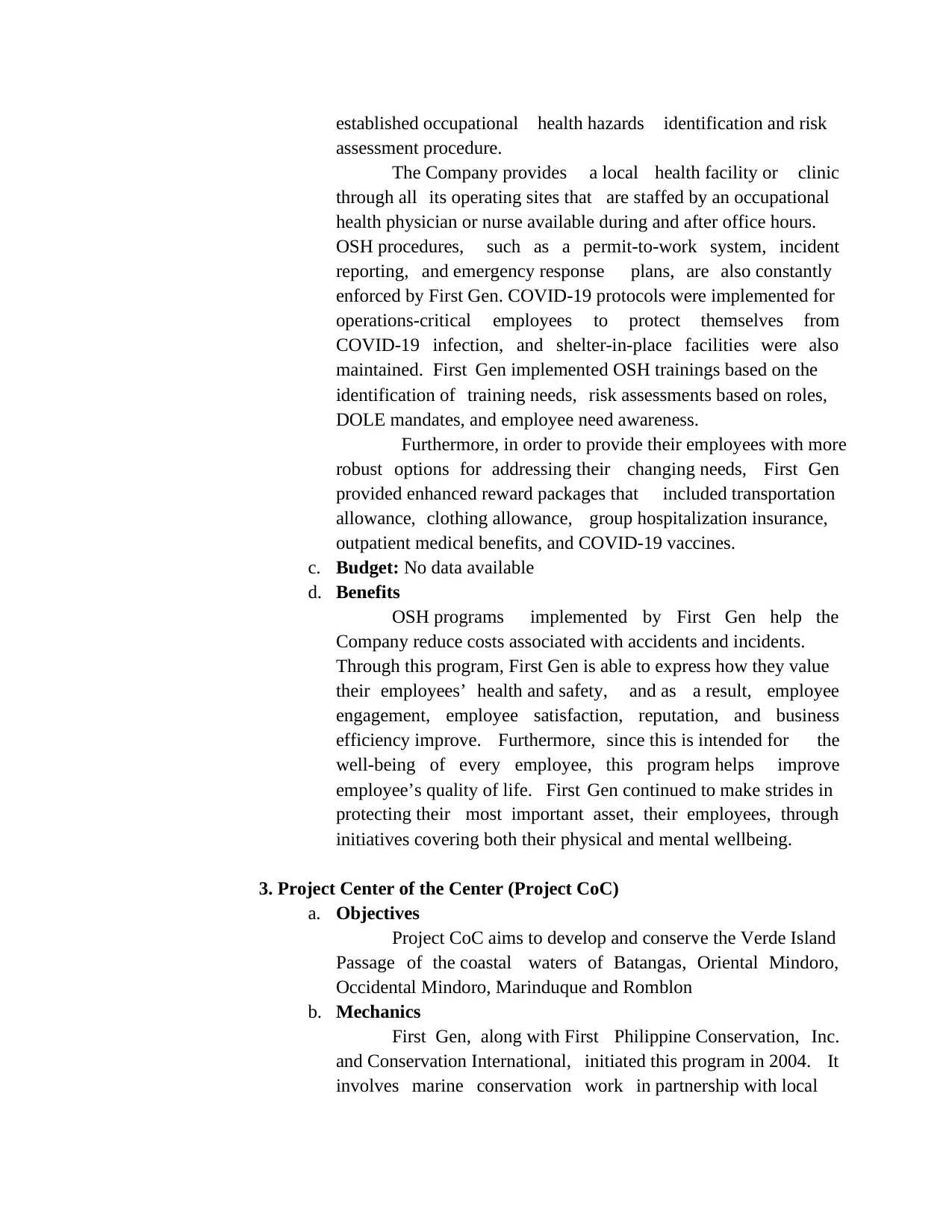
established occupational health hazards identification and risk
assessment procedure.
The Company provides a local health facility or clinic
through all its operating sites that are staffed by an occupational
health physician or nurse available during and after office hours.
OSH procedures, such as a permit-to-work system, incident
reporting, and emergency response plans, are also constantly
enforced by First Gen. COVID-19 protocols were implemented for
operations-critical employees to protect themselves from
COVID-19 infection, and shelter-in-place facilities were also
maintained. First Gen implemented OSH trainings based on the
identification of training needs, risk assessments based on roles,
DOLE mandates, and employee need awareness.
Furthermore, in order to provide their employees with more
robust options for addressing their changing needs, First Gen
provided enhanced reward packages that included transportation
allowance, clothing allowance, group hospitalization insurance,
outpatient medical benefits, and COVID-19 vaccines.
c. Budget: No data available
d. Benefits
OSH programs implemented by First Gen help the
Company reduce costs associated with accidents and incidents.
Through this program, First Gen is able to express how they value
their employees’ health and safety, and as a result, employee
engagement, employee satisfaction, reputation, and business
efficiency improve. Furthermore, since this is intended for the
well-being of every employee, this program helps improve
employee’s quality of life. First Gen continued to make strides in
protecting their most important asset, their employees, through
initiatives covering both their physical and mental wellbeing.
3. Project Center of the Center (Project CoC)
a. Objectives
Project CoC aims to develop and conserve the Verde Island
Passage of the coastal waters of Batangas, Oriental Mindoro,
Occidental Mindoro, Marinduque and Romblon
b. Mechanics
First Gen, along with First Philippine Conservation, Inc.
and Conservation International, initiated this program in 2004. It
involves marine conservation work in partnership with local
assessment procedure.
The Company provides a local health facility or clinic
through all its operating sites that are staffed by an occupational
health physician or nurse available during and after office hours.
OSH procedures, such as a permit-to-work system, incident
reporting, and emergency response plans, are also constantly
enforced by First Gen. COVID-19 protocols were implemented for
operations-critical employees to protect themselves from
COVID-19 infection, and shelter-in-place facilities were also
maintained. First Gen implemented OSH trainings based on the
identification of training needs, risk assessments based on roles,
DOLE mandates, and employee need awareness.
Furthermore, in order to provide their employees with more
robust options for addressing their changing needs, First Gen
provided enhanced reward packages that included transportation
allowance, clothing allowance, group hospitalization insurance,
outpatient medical benefits, and COVID-19 vaccines.
c. Budget: No data available
d. Benefits
OSH programs implemented by First Gen help the
Company reduce costs associated with accidents and incidents.
Through this program, First Gen is able to express how they value
their employees’ health and safety, and as a result, employee
engagement, employee satisfaction, reputation, and business
efficiency improve. Furthermore, since this is intended for the
well-being of every employee, this program helps improve
employee’s quality of life. First Gen continued to make strides in
protecting their most important asset, their employees, through
initiatives covering both their physical and mental wellbeing.
3. Project Center of the Center (Project CoC)
a. Objectives
Project CoC aims to develop and conserve the Verde Island
Passage of the coastal waters of Batangas, Oriental Mindoro,
Occidental Mindoro, Marinduque and Romblon
b. Mechanics
First Gen, along with First Philippine Conservation, Inc.
and Conservation International, initiated this program in 2004. It
involves marine conservation work in partnership with local
⊘ This is a preview!⊘
Do you want full access?
Subscribe today to unlock all pages.

Trusted by 1+ million students worldwide
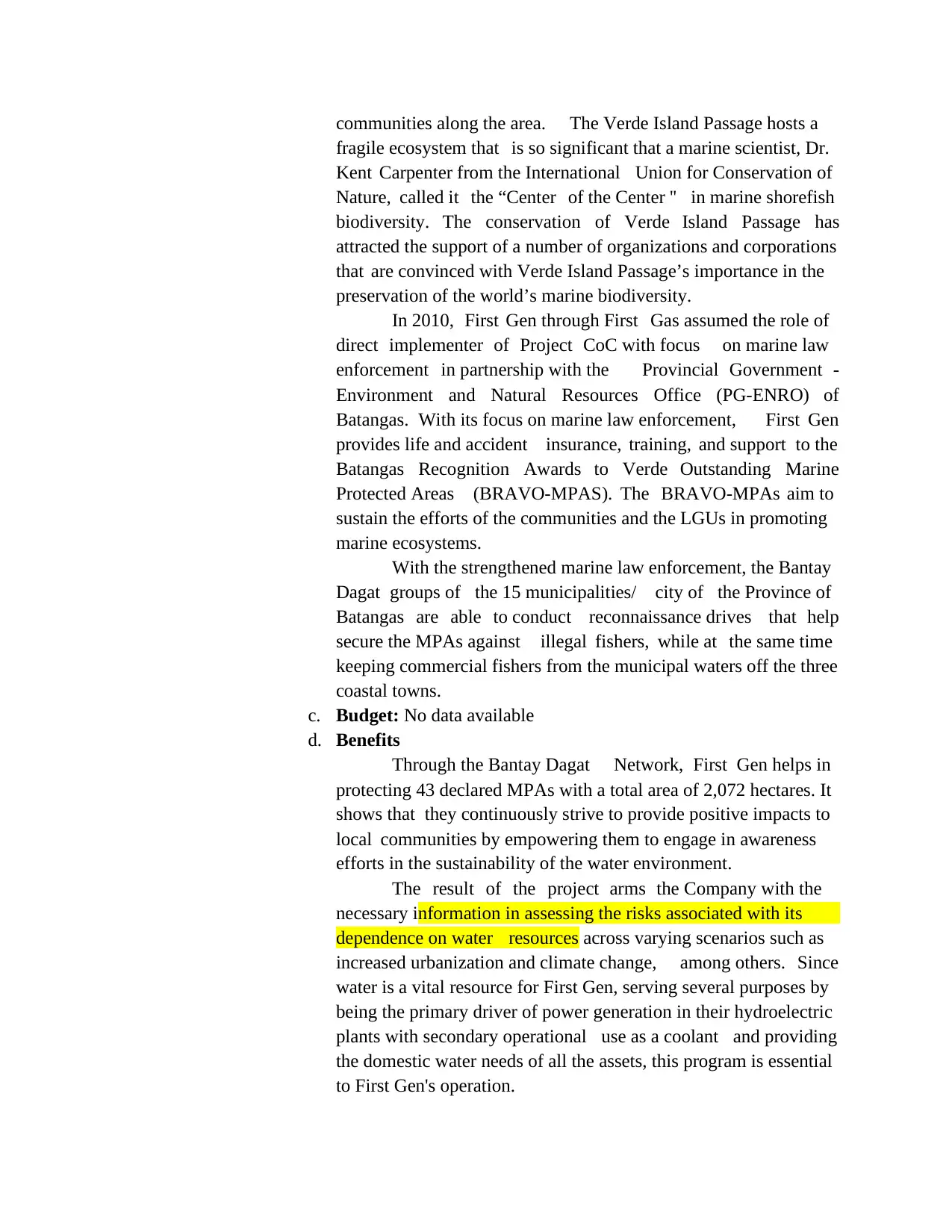
communities along the area. The Verde Island Passage hosts a
fragile ecosystem that is so significant that a marine scientist, Dr.
Kent Carpenter from the International Union for Conservation of
Nature, called it the “Center of the Center '' in marine shorefish
biodiversity. The conservation of Verde Island Passage has
attracted the support of a number of organizations and corporations
that are convinced with Verde Island Passage’s importance in the
preservation of the world’s marine biodiversity.
In 2010, First Gen through First Gas assumed the role of
direct implementer of Project CoC with focus on marine law
enforcement in partnership with the Provincial Government -
Environment and Natural Resources Office (PG-ENRO) of
Batangas. With its focus on marine law enforcement, First Gen
provides life and accident insurance, training, and support to the
Batangas Recognition Awards to Verde Outstanding Marine
Protected Areas (BRAVO-MPAS). The BRAVO-MPAs aim to
sustain the efforts of the communities and the LGUs in promoting
marine ecosystems.
With the strengthened marine law enforcement, the Bantay
Dagat groups of the 15 municipalities/ city of the Province of
Batangas are able to conduct reconnaissance drives that help
secure the MPAs against illegal fishers, while at the same time
keeping commercial fishers from the municipal waters off the three
coastal towns.
c. Budget: No data available
d. Benefits
Through the Bantay Dagat Network, First Gen helps in
protecting 43 declared MPAs with a total area of 2,072 hectares. It
shows that they continuously strive to provide positive impacts to
local communities by empowering them to engage in awareness
efforts in the sustainability of the water environment.
The result of the project arms the Company with the
necessary information in assessing the risks associated with its
dependence on water resources across varying scenarios such as
increased urbanization and climate change, among others. Since
water is a vital resource for First Gen, serving several purposes by
being the primary driver of power generation in their hydroelectric
plants with secondary operational use as a coolant and providing
the domestic water needs of all the assets, this program is essential
to First Gen's operation.
fragile ecosystem that is so significant that a marine scientist, Dr.
Kent Carpenter from the International Union for Conservation of
Nature, called it the “Center of the Center '' in marine shorefish
biodiversity. The conservation of Verde Island Passage has
attracted the support of a number of organizations and corporations
that are convinced with Verde Island Passage’s importance in the
preservation of the world’s marine biodiversity.
In 2010, First Gen through First Gas assumed the role of
direct implementer of Project CoC with focus on marine law
enforcement in partnership with the Provincial Government -
Environment and Natural Resources Office (PG-ENRO) of
Batangas. With its focus on marine law enforcement, First Gen
provides life and accident insurance, training, and support to the
Batangas Recognition Awards to Verde Outstanding Marine
Protected Areas (BRAVO-MPAS). The BRAVO-MPAs aim to
sustain the efforts of the communities and the LGUs in promoting
marine ecosystems.
With the strengthened marine law enforcement, the Bantay
Dagat groups of the 15 municipalities/ city of the Province of
Batangas are able to conduct reconnaissance drives that help
secure the MPAs against illegal fishers, while at the same time
keeping commercial fishers from the municipal waters off the three
coastal towns.
c. Budget: No data available
d. Benefits
Through the Bantay Dagat Network, First Gen helps in
protecting 43 declared MPAs with a total area of 2,072 hectares. It
shows that they continuously strive to provide positive impacts to
local communities by empowering them to engage in awareness
efforts in the sustainability of the water environment.
The result of the project arms the Company with the
necessary information in assessing the risks associated with its
dependence on water resources across varying scenarios such as
increased urbanization and climate change, among others. Since
water is a vital resource for First Gen, serving several purposes by
being the primary driver of power generation in their hydroelectric
plants with secondary operational use as a coolant and providing
the domestic water needs of all the assets, this program is essential
to First Gen's operation.
Paraphrase This Document
Need a fresh take? Get an instant paraphrase of this document with our AI Paraphraser
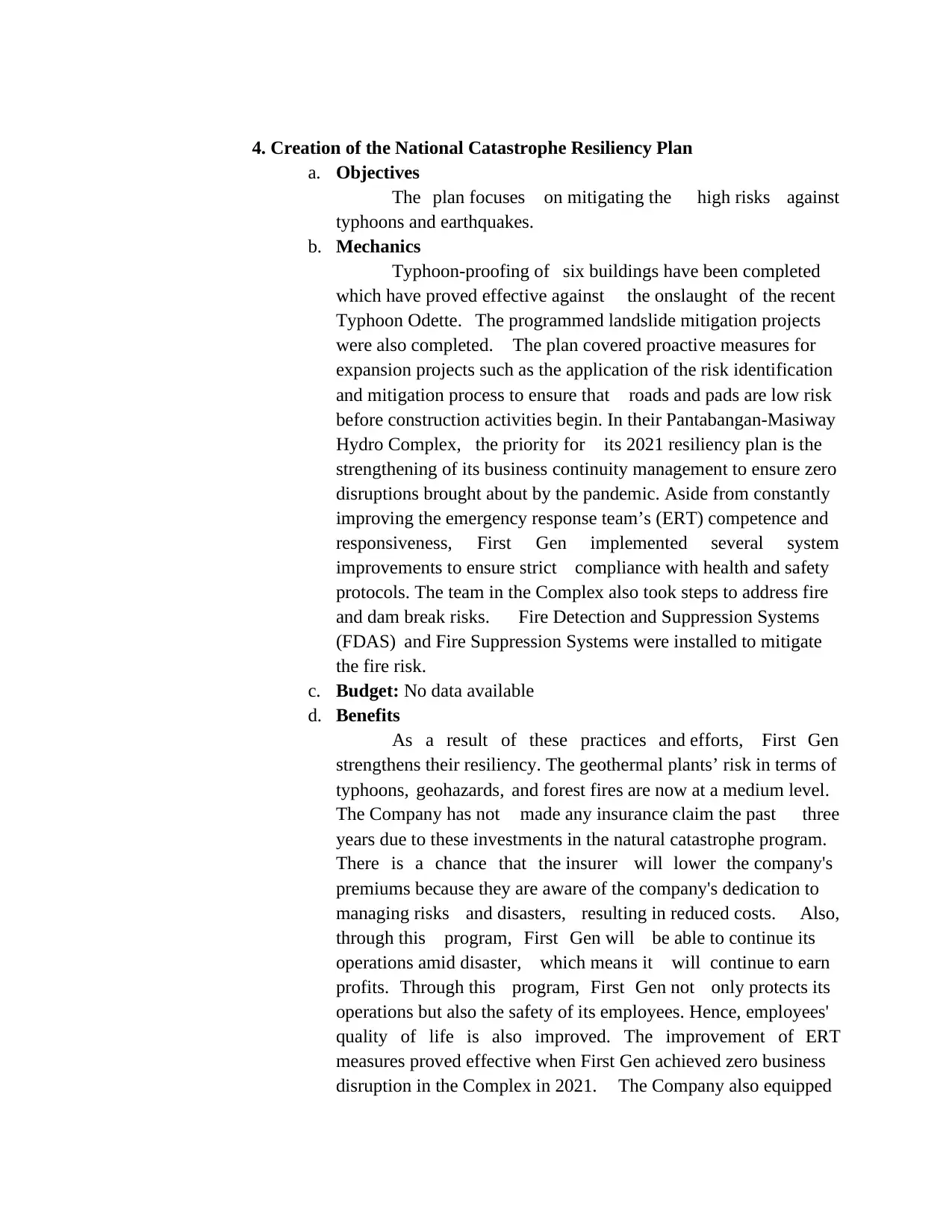
4. Creation of the National Catastrophe Resiliency Plan
a. Objectives
The plan focuses on mitigating the high risks against
typhoons and earthquakes.
b. Mechanics
Typhoon-proofing of six buildings have been completed
which have proved effective against the onslaught of the recent
Typhoon Odette. The programmed landslide mitigation projects
were also completed. The plan covered proactive measures for
expansion projects such as the application of the risk identification
and mitigation process to ensure that roads and pads are low risk
before construction activities begin. In their Pantabangan-Masiway
Hydro Complex, the priority for its 2021 resiliency plan is the
strengthening of its business continuity management to ensure zero
disruptions brought about by the pandemic. Aside from constantly
improving the emergency response team’s (ERT) competence and
responsiveness, First Gen implemented several system
improvements to ensure strict compliance with health and safety
protocols. The team in the Complex also took steps to address fire
and dam break risks. Fire Detection and Suppression Systems
(FDAS) and Fire Suppression Systems were installed to mitigate
the fire risk.
c. Budget: No data available
d. Benefits
As a result of these practices and efforts, First Gen
strengthens their resiliency. The geothermal plants’ risk in terms of
typhoons, geohazards, and forest fires are now at a medium level.
The Company has not made any insurance claim the past three
years due to these investments in the natural catastrophe program.
There is a chance that the insurer will lower the company's
premiums because they are aware of the company's dedication to
managing risks and disasters, resulting in reduced costs. Also,
through this program, First Gen will be able to continue its
operations amid disaster, which means it will continue to earn
profits. Through this program, First Gen not only protects its
operations but also the safety of its employees. Hence, employees'
quality of life is also improved. The improvement of ERT
measures proved effective when First Gen achieved zero business
disruption in the Complex in 2021. The Company also equipped
a. Objectives
The plan focuses on mitigating the high risks against
typhoons and earthquakes.
b. Mechanics
Typhoon-proofing of six buildings have been completed
which have proved effective against the onslaught of the recent
Typhoon Odette. The programmed landslide mitigation projects
were also completed. The plan covered proactive measures for
expansion projects such as the application of the risk identification
and mitigation process to ensure that roads and pads are low risk
before construction activities begin. In their Pantabangan-Masiway
Hydro Complex, the priority for its 2021 resiliency plan is the
strengthening of its business continuity management to ensure zero
disruptions brought about by the pandemic. Aside from constantly
improving the emergency response team’s (ERT) competence and
responsiveness, First Gen implemented several system
improvements to ensure strict compliance with health and safety
protocols. The team in the Complex also took steps to address fire
and dam break risks. Fire Detection and Suppression Systems
(FDAS) and Fire Suppression Systems were installed to mitigate
the fire risk.
c. Budget: No data available
d. Benefits
As a result of these practices and efforts, First Gen
strengthens their resiliency. The geothermal plants’ risk in terms of
typhoons, geohazards, and forest fires are now at a medium level.
The Company has not made any insurance claim the past three
years due to these investments in the natural catastrophe program.
There is a chance that the insurer will lower the company's
premiums because they are aware of the company's dedication to
managing risks and disasters, resulting in reduced costs. Also,
through this program, First Gen will be able to continue its
operations amid disaster, which means it will continue to earn
profits. Through this program, First Gen not only protects its
operations but also the safety of its employees. Hence, employees'
quality of life is also improved. The improvement of ERT
measures proved effective when First Gen achieved zero business
disruption in the Complex in 2021. The Company also equipped
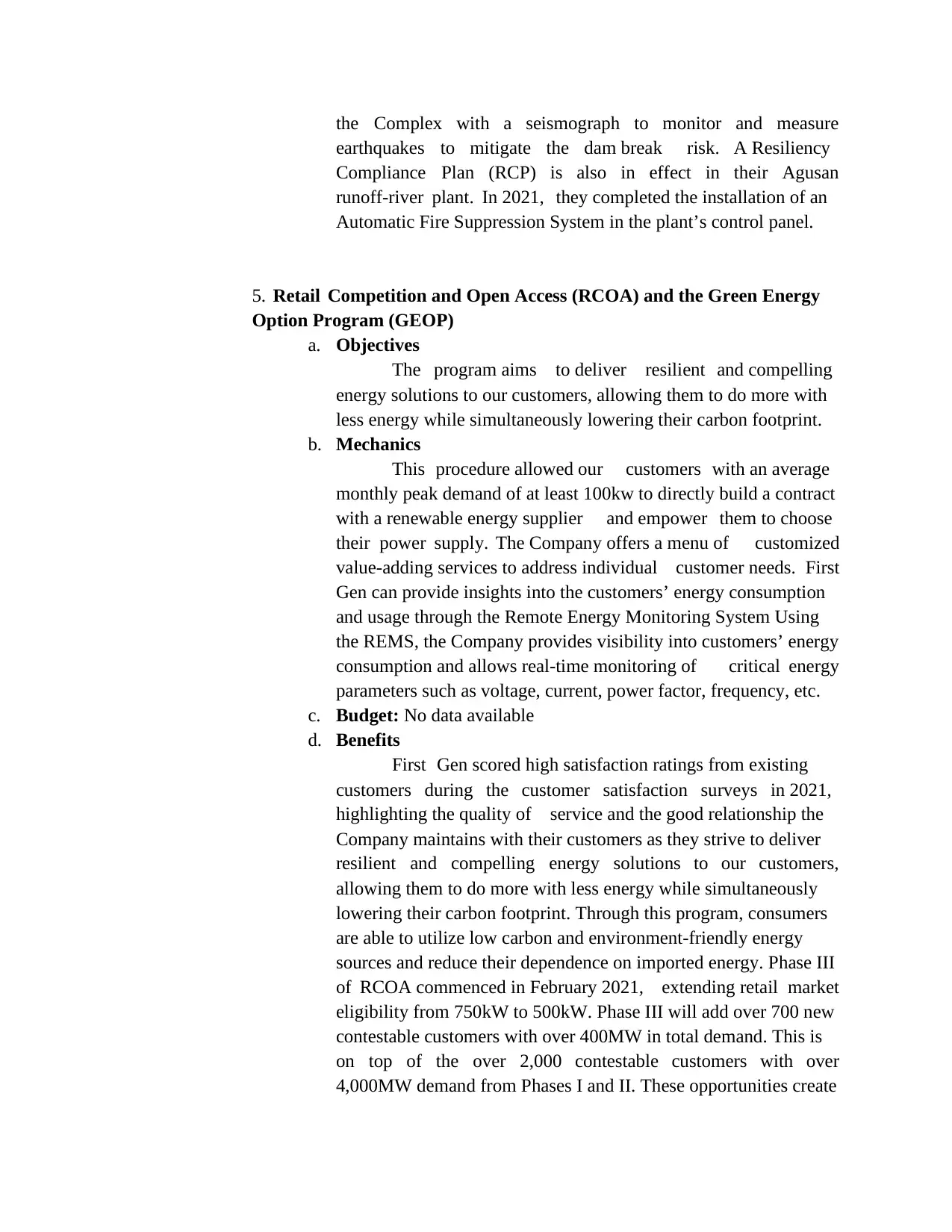
the Complex with a seismograph to monitor and measure
earthquakes to mitigate the dam break risk. A Resiliency
Compliance Plan (RCP) is also in effect in their Agusan
runoff-river plant. In 2021, they completed the installation of an
Automatic Fire Suppression System in the plant’s control panel.
5. Retail Competition and Open Access (RCOA) and the Green Energy
Option Program (GEOP)
a. Objectives
The program aims to deliver resilient and compelling
energy solutions to our customers, allowing them to do more with
less energy while simultaneously lowering their carbon footprint.
b. Mechanics
This procedure allowed our customers with an average
monthly peak demand of at least 100kw to directly build a contract
with a renewable energy supplier and empower them to choose
their power supply. The Company offers a menu of customized
value-adding services to address individual customer needs. First
Gen can provide insights into the customers’ energy consumption
and usage through the Remote Energy Monitoring System Using
the REMS, the Company provides visibility into customers’ energy
consumption and allows real-time monitoring of critical energy
parameters such as voltage, current, power factor, frequency, etc.
c. Budget: No data available
d. Benefits
First Gen scored high satisfaction ratings from existing
customers during the customer satisfaction surveys in 2021,
highlighting the quality of service and the good relationship the
Company maintains with their customers as they strive to deliver
resilient and compelling energy solutions to our customers,
allowing them to do more with less energy while simultaneously
lowering their carbon footprint. Through this program, consumers
are able to utilize low carbon and environment-friendly energy
sources and reduce their dependence on imported energy. Phase III
of RCOA commenced in February 2021, extending retail market
eligibility from 750kW to 500kW. Phase III will add over 700 new
contestable customers with over 400MW in total demand. This is
on top of the over 2,000 contestable customers with over
4,000MW demand from Phases I and II. These opportunities create
earthquakes to mitigate the dam break risk. A Resiliency
Compliance Plan (RCP) is also in effect in their Agusan
runoff-river plant. In 2021, they completed the installation of an
Automatic Fire Suppression System in the plant’s control panel.
5. Retail Competition and Open Access (RCOA) and the Green Energy
Option Program (GEOP)
a. Objectives
The program aims to deliver resilient and compelling
energy solutions to our customers, allowing them to do more with
less energy while simultaneously lowering their carbon footprint.
b. Mechanics
This procedure allowed our customers with an average
monthly peak demand of at least 100kw to directly build a contract
with a renewable energy supplier and empower them to choose
their power supply. The Company offers a menu of customized
value-adding services to address individual customer needs. First
Gen can provide insights into the customers’ energy consumption
and usage through the Remote Energy Monitoring System Using
the REMS, the Company provides visibility into customers’ energy
consumption and allows real-time monitoring of critical energy
parameters such as voltage, current, power factor, frequency, etc.
c. Budget: No data available
d. Benefits
First Gen scored high satisfaction ratings from existing
customers during the customer satisfaction surveys in 2021,
highlighting the quality of service and the good relationship the
Company maintains with their customers as they strive to deliver
resilient and compelling energy solutions to our customers,
allowing them to do more with less energy while simultaneously
lowering their carbon footprint. Through this program, consumers
are able to utilize low carbon and environment-friendly energy
sources and reduce their dependence on imported energy. Phase III
of RCOA commenced in February 2021, extending retail market
eligibility from 750kW to 500kW. Phase III will add over 700 new
contestable customers with over 400MW in total demand. This is
on top of the over 2,000 contestable customers with over
4,000MW demand from Phases I and II. These opportunities create
⊘ This is a preview!⊘
Do you want full access?
Subscribe today to unlock all pages.

Trusted by 1+ million students worldwide
1 out of 20
Your All-in-One AI-Powered Toolkit for Academic Success.
+13062052269
info@desklib.com
Available 24*7 on WhatsApp / Email
![[object Object]](/_next/static/media/star-bottom.7253800d.svg)
Unlock your academic potential
Copyright © 2020–2025 A2Z Services. All Rights Reserved. Developed and managed by ZUCOL.
